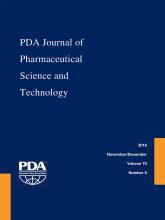Abstract
Aspartate (Asp) isomerization is a common post-translational modification of recombinant therapeutic proteins that can occur during manufacturing, storage, or administration. Asp isomerization in the complementarity-determining regions of a monoclonal antibody may affect the target binding and thus a sufficiently robust quality control method for routine monitoring is desirable. In this work, we utilized a liquid chromatography–mass spectrometry (LC/MS)-based approach to identify the Asp isomerization in the complementarity-determining regions of a therapeutic monoclonal antibody. To quantitate the site-specific Asp isomerization of the monoclonal antibody, a UV detection–based quantitation assay utilizing the same LC platform was developed. The assay was qualified and implemented for routine monitoring of this product-specific modification. Compared with existing methods, this analytical paradigm is applicable to identify Asp isomerization (or other modifications) and subsequently develop a rapid, sufficiently robust quality control method for routine site-specific monitoring and quantitation to ensure product quality. This approach first identifies and locates a product-related impurity (a critical quality attribute) caused by isomerization, deamidation, oxidation, or other post-translational modifications, and then utilizes synthetic peptides and MS to assist the development of a LC-UV–based chromatographic method that separates and quantifies the product-related impurities by UV peaks. The established LC-UV method has acceptable peak specificity, precision, linearity, and accuracy; it can be validated and used in a good manufacturing practice environment for lot release and stability testing.
LAY ABSTRACT: Aspartate isomerization is a common post-translational modification of recombinant proteins during manufacture process and storage. Isomerization in the complementarity-determining regions (CDRs) of a monoclonal antibody A (mAb-A) has been detected and has been shown to have impact on the binding affinity to the antigen. In this work, we utilized a mass spectrometry–based peptide mapping approach to detect and quantitate the Asp isomerization in the CDRs of mAb-A. To routinely monitor the CDR isomerization of mAb-A, a focused peptide mapping method utilizing reversed phase chromatographic separation and UV detection has been developed and qualified. This approach is generally applicable to monitor isomerization and other post-translational modifications of proteins in a specific and high-throughput mode to ensure product quality.
- Monoclonal antibody (mAb)
- Complementarity-determining regions (CDRs)
- Aspartic acid isomerization
- Focused peptide mapping
- Method qualification
Footnotes
- © PDA, Inc. 2016
PDA members receive access to all articles published in the current year and previous volume year. Institutional subscribers received access to all content. Log in below to receive access to this article if you are either of these.
If you are neither or you are a PDA member trying to access an article outside of your membership license, then you must purchase access to this article (below). If you do not have a username or password for JPST, you will be required to create an account prior to purchasing.
Full issue PDFs are for PDA members only.
Note to pda.org users
The PDA and PDA bookstore websites (www.pda.org and www.pda.org/bookstore) are separate websites from the PDA JPST website. When you first join PDA, your initial UserID and Password are sent to HighWirePress to create your PDA JPST account. Subsequent UserrID and Password changes required at the PDA websites will not pass on to PDA JPST and vice versa. If you forget your PDA JPST UserID and/or Password, you can request help to retrieve UserID and reset Password below.






